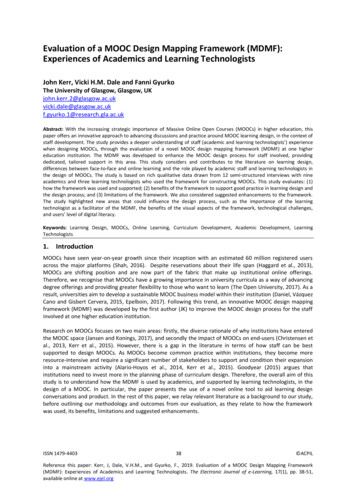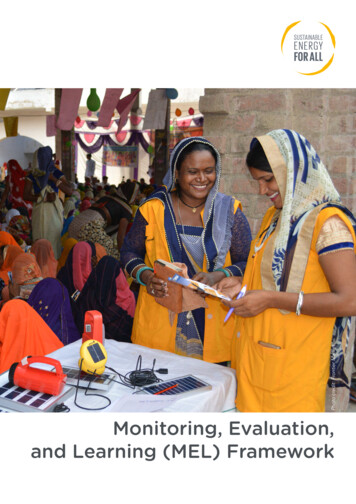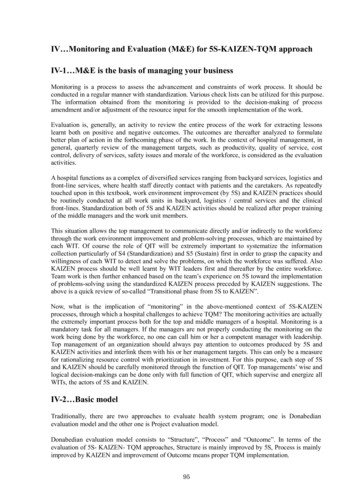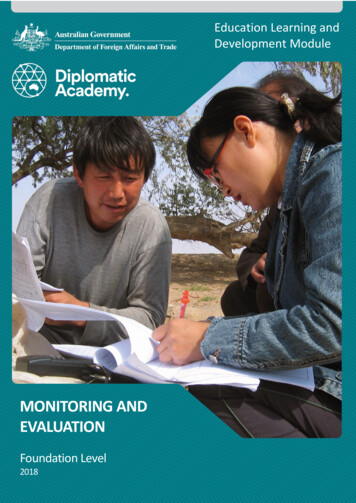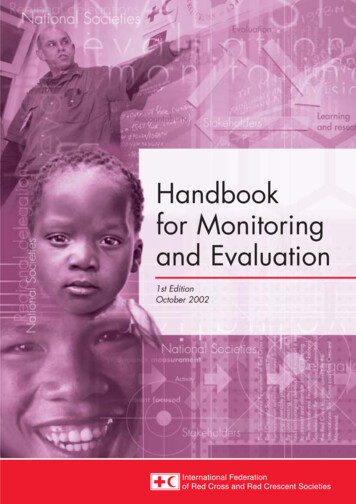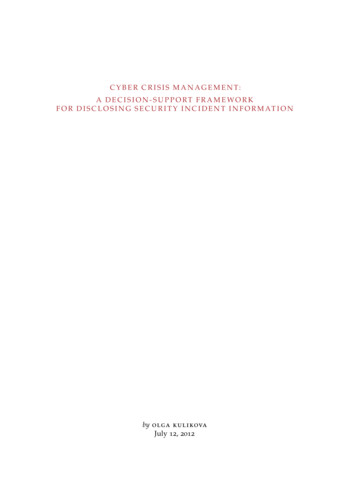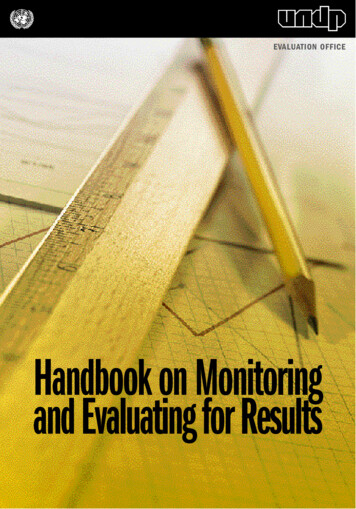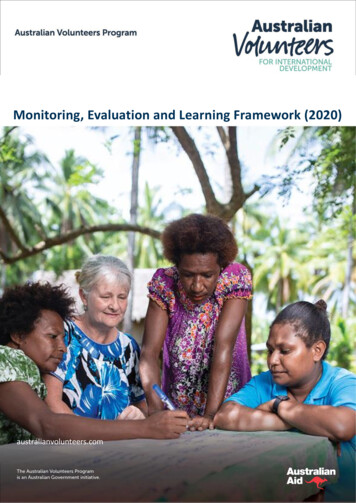
Transcription
Monitoring, Evaluation and Learning Framework (2020)australianvolunteers.com
Preferred citation: Australian Volunteers Program – Monitoring, Evaluation and Learning Framework (2020)For further information, please contact:Australian Volunteers Program Contractor Representative:Louise MorrisonCardno Emerging Markets (Australia) Pty LtdLevel 4, 501 Swanston Street, Melbourne, 3000 61 3 9937 0754The Australian Volunteers Program is an Australian Government initiative. The program is managed by AVI, in aconsortium with Cardno Emerging Markets Pty Ltd and Whitelum Group.The views expressed in this publication are the author’s alone and are not necessarily the views of the AustralianGovernment.Photos: Harjono Djoyobisono / AVIVersionIssue DateMaintained ByReviewed ByAmendment11 December 2017MEL ManagerDFAT AVSFirst issue.21 May 2020MEL ManagerDFAT AVSRevisions throughoutaustralianvolunteers.comi
1.Purpose of the MEL Framework . 42.The Australian Volunteers Program . 43.Overview of the MEL Framework . 44.The Australian Volunteers Program Logic . 54.1.Program logic . 54.2.Assumptions (risks to delivery of program outcomes) . 75.Assessing Progress . 85.1.Key evaluation questions . 85.2.Program indicators. 95.3.Tools for data collection . 115.3.1.5.4.Evaluation . 135.4.1.Internal evaluation for program learning and improvement . 135.4.2.External evaluation . 145.5.6.When tools will be ready for use . 13Impact Areas, SDGs, cross-cutting issues and development priorities . 15Understanding and Using Performance Information . 166.1.Annual reflection cycle. 166.2.Uses of MEL data . 177.6.2.1.Program learning and information sharing . 176.2.2.Governance and management decision making . 186.2.3.Public diplomacy and communications . 196.2.4.Reporting and accountability. 19M&E Roles and Responsibilities. 207.1.Australian Volunteers Program team roles . 207.2.Approach to capacity building for Australian Volunteers Program staff . 217.3.DFAT roles . 218.Risks to Effective MEL delivery . 229.Annual MEL Plan . 2410.Ethical Principles and Standards . 2410.1.Ethical principles in MEL . 2510.2.Ethical standards . 2611.MEL Budget . 27ii
Abbreviations and AcronymsAOsAustralian OrganisationsAVPAustralian Volunteers Program (acronym for internal use only)AVSAustralian Volunteers Section (in DFAT)DFATDepartment of Foreign Affairs and TradeMELMonitoring, Evaluation and LearningMELFMonitoring, Evaluation and Learning FrameworkMISManagement Information SystemPOsPartner OrganisationsRAVNReturned Australian Volunteers NetworkSDGSustainable Development Goaliii
1. Purpose of MEL FrameworkThe Monitoring, Evaluation and Learning Framework (MELF) sets out the approach to assessing theperformance of the Australian Volunteers Program. The Framework identifies the evidence that will begenerated to enable: accountability to DFAT, program partners, and the publicprogram performance and management decision-making for DFAT and the program teamlearning and continuous improvement to ensure effective program deliverystronger understanding of good volunteer practice within DFAT and the wider volunteer communitycommunications to promote the value of volunteering in Australia and in partner countries.The MELF covers the initial five years of the program. It will be regularly reviewed and updated to reflectchanges as the program adapts and learns more about how to best monitor and evaluate the performance ofthe Australian Volunteers Program.The MELF is a requirement of Clause 8.1 of the Head Contract with a due date of 1 December 2017. Thisdocument has been generated by the program team, with input from DFAT AVS. It was first submitted to DFATon 1 December 2017, and reviewed and revised in February 2020.2. Australian Volunteers ProgramThe Australian Volunteers Program is an Australian Government initiative. It builds on the AustralianGovernment's investment in international volunteers over the past 60 years. The program replaced theAustralian Volunteers for International Development (AVID) program, which concluded on 31 December 2017.The new program retains the core elements of AVID and enhances the program’s reach, visibility and impact.The Australian Volunteers Program is managed by AVI, in a consortium with Cardno Emerging Markets Pty Ltdand Whitelum Group. It is a five-year program with an estimated total budget of AU 190 million.The Australian Volunteers Program matches skilled Australians from all walks of life with organisations indeveloping countries to help these organisations to deliver on their own objectives. The program usesinternational volunteering as a people-centred approach to capacity development. The Australian VolunteersProgram is part of the Australian Government’s people-to-people program portfolio, connecting Australians toAustralia’s aid program and the region.The Australian Volunteers Program is guided by a Global Program Strategy that sets out the strategic direction,policy context, guiding principles and priorities for the program. It informs plans, partnerships and volunteerassignments at the country level, which align with partner countries developmental objectives and Australia’said investment plans. The strategy is framed by and contributes to Australia’s aid policy, the Foreign PolicyWhite Paper and the Sustainable Development Goals (SDGs). The program’s MELF, alongside a range otherprogram-level strategies, supports the strategy and effective program implementation.3. Overview of the MEL FrameworkThe core sections of the MELF articulate:1. What the program intends to achieve: the program logic describes what the program hopes to achieveover the next five years, and how it aims to influence change, both in Australia and overseas.2. How progress will be tracked, which includes:australianvolunteers.com4
key evaluation questions to guide all monitoring, evaluation and learning activitiesindicators for regular monitoringtools to support regular data collection on the indicators, andevaluative activities to provide a deeper understanding of aspects of the program3. The process of making sense of program evidence and the ways the evidence will be used in theprogram.4. The roles and responsibilities for delivering on the MELF.5. The risks to MELF delivery.6. The annual priorities for the MELF.7. The ethical principles that guide the MELF.8. The Monitoring, Evaluation and Learning (MEL) budget.4. Australian Volunteers Program Logic4.1. Program logicThe program logic identifies the relationship between the program’s actions and the intended changes it aimsto support. It also identifies underlying assumptions that are key to ensuring outcomes will be achieved asplanned.The program logic has been reviewed and refined with input from DFAT and Australian Volunteers Programstaff. It is highly aligned with the program logic in the design document, with minor amendments to clarifysome of the outcome statements, and more clearly articulate how the public diplomacy outcomes will beachieved.The Australian Volunteers Program has three end of program outcomes that the program aims to deliver onover the next five years. These are described in more detail below:A.Partner organisations are supported by Australia to progress their development objectives. TheAustralian Volunteers Program will partner with a range of organisations to help strengthen theircapacity to deliver on their development objectives. The nature of partnership implies that both thepartner organisations and the Australian Volunteers Program have shared objectives and both partiesbenefit from, and contribute to, the partnership.The program supports a strong link between development objectives in partner countries, Australia’sdevelopment priorities, and the selection of partner organisations. (See Figure 1 below).Figure 1Relationship between partner organisation selection and development objectivesCountryDevelopmentPriorities &SDGsDFAT AidInvestmentPlanAustralia’s aidprioritiesCountryProgram PlanPriority sectorsand priority POtypesPO selection(PartnershipPlan)VolunteerAssignments5
The logic states that if partner organisations have a strategic rationale for participating in the program1 andprovide a safe and productive working environment for the volunteers, the volunteer will have a goodexperience and strengthen capacity within the partner organisation. By strengthening partner organisationcapacity (staff skills and capability, improving systems and contributing to improved organisational processes),partner organisations will be able to progress their development objectives.The program will support partner organisations to progress their development objectives by: B.Establishing relevant (to country priorities) and diverse partnerships, both in Australia and overseas, with arange of organisations (community based organisations, private sector, government organisations,academic institutions, peak bodies, etc.).Establishing and regularly reviewing Partnership Plans2 which set out how partners and the AustralianVolunteers Program will work together to resource capacity needs that support partners to deliver on theirdevelopment outcomes.Raising awareness in Australian organisations, potential partner organisations and within DFAT (post, stateoffices and Canberra) of the benefits of volunteers and the approaches of the Australian VolunteersProgram.Trialling and offering different volunteering approaches to strengthen organisational capacity (evolunteering, multiple assignments, cluster assignments etc.)The public in Australia better appreciates the value of international volunteering. The AustralianVolunteers Program has a purposeful focus on promoting the value of volunteering. The logic states thatif Australian organisations, partner organisations, champions, volunteers (past and present) and DFATpromote the benefits of volunteering then the public in Australia will better appreciate the value ofvolunteering.The program will support audiences in Australia and partner countries to better understand the value ofvolunteering. The aim is to ensure target audiences are aware of the program, and shift audiences (potentialvolunteers, potential partner organisations, potential Australian organisations) from awareness to being moreengaged in the program through: Supporting volunteers, partner organisations, Australian organisations and Post to identify opportunitiesto engage and inform their constituencies about the value of volunteer contributions to internationaldevelopment outcomes.Supporting volunteers, partner organisationsand Australian organisationsto contribute relevant, engagingand influential communications to be distributed through program channels to external media anddomestic and global target audiences.Capturing and promoting learning about achievements and innovations of the Australian VolunteersProgram.1including identifying the capacity gaps and required skill sets of the volunteers, it is more likely they will work with the volunteer to progresstheir development objectives2 Partnership Plans include capacity development plans. Partnership Plans will be reviewed every 12 to 18 months. Defining capacity needs,assessment of capacity development, and sustainability planning are part of this process.6
C.Australian volunteers gain professionally and personally. Well supported and strategically placedvolunteers that have a good experience and contribute to partner organisations are at the heart of asuccessful volunteering program. The logic states that if the program supports a diverse range ofvolunteers who have the right skills, attitudes and attributes for the assignment, then those volunteerswill complete their assignments well and have a positive experience. Whilst on assignment andafterwards, volunteers will promote greater cultural awareness and build strong connections betweenpartner countries and Australia which will result in the volunteers gaining both personally andprofessionally.The program will support the volunteers to gain professionally and personally by: ensuring the program is inclusive and accessible to a broad range of skilled Australians (in line with theprogram’s Diversity and Inclusion strategy’s focus on: Disability inclusion; Indigenous persons; Diasporaand diverse cultural backgrounds; Gender equality; LGBT ; Remote, rural and regional persons; Youngerand older persons)having strong volunteer recruitment practices (targeted to country needs)supporting volunteers prior to, on-assignment and afterwards with fit-for purpose learning anddevelopment programs and networksBy successfully achieving these three end of program outcomes, the Australian Volunteers Program will havecontributed to longer term development and diplomacy goals: the Australian Government is achieving its development objectivesAustralians become more globally literate and connectedAustralian aid is perceived positively in Australia and overseasThe program logic is available in Annex 1.4.2. Assumptions (risks to delivery of program outcomes)The achievement of program outcomes, as articulated in the program logic, is based on a number of underlyingassumptions, which define conditions assumed to be in place. Reframed, these assumptions are actually risksto the delivery of program outcomes.Tracking progress against the program logic through monitoring and regular reflection, provides theopportunity to determine whether these assumptions have held or not, and whether or how they will affectthe achievement of results. The MELF data collection tools aim to provide insights into these assumptions(risks). As part of the Annual Reflection events (Section 6.1), assumptions in the program logic will be reviewedand tested.The assumptions are: there will be ongoing bi-partisan support for the Australian Volunteers Programvolunteers have a positive volunteering experiencethe successful delivery of volunteer assignments will make a real contribution to partner organisations’ability to achieve their objectivesthe success of volunteer assignments and partner capacity development, will meaningfully contribute toAustralia’s development and public diplomacy objectivespotential, current and returned volunteers have a positive perception of the Australian aid program andAustralia’s development objectives overseas7
most volunteers will want to share their volunteering experiences and articulate how volunteerscontribute to development outcomes with others in Australia and overseas Australian organisations, partner organisations, champions and DFAT see value in and will activelypromote the benefits of the volunteer program with the right support, volunteering overseas can be an attractive and accessible opportunity to skilledAustralians from all walks of life a diverse and relevant range of Australian organisations and in-country partner organisations will beinterested in and have the capacity to partner with the program DFAT post, Canberra and State offices will be interested in strategically engaging with the volunteerprogram and leveraging the program to support the delivery of development outcomesRisks to delivery of the MELF are captured in Section 8.5. Assessing progressThe approach to assessing progress in the Australian Volunteers Program draws on some of the key principlesof developmental evaluation3 to provide, as far as possible, real time data that helps to interpret what isworking and what is not within the program. Whilst the Australian Volunteers Program has a (relatively) linearand seemingly simple program logic (Annex 1), the reality is that the Australian Volunteers Program isoperating in a multitude of complex operating environments. Building capacity of partner organisations, andunderstanding how to influence public diplomacy are situation specific and complex undertakings. Theelements of developmental evaluation being applied include: A heavy emphasis on monitoring using multiple sources and obtaining (as far as possible) real time dataIdentifying patterns in data that may prompt new thinkingInterpretation and meaning being assigned by those involved in delivering the program through a processof asking what does the data tell us? So what does it mean for the way we operate and the partnershipswe have? Now what are we going to do (same or differently)?The focus is on learning and using reflection to test whether we are on the right path to achieving thedesired outcomes5.1. Key evaluation questionsKey evaluation questions are high level questions designed to frame the analysis of progress and performanceof the Australian Volunteers Program. They will be used by the program to help structure regular reflectionevents, and to guide reporting. The key evaluation questions in the design document were reviewed andrefined by the program team.Effectiveness What have been the outcomes4 / results (intended and unintended, positive and negative) of theprogram for volunteers, partner organisations, development in partner countries, and raisingawareness of the value of volunteering?To what extent has the program contributed to these outcomes?To what extent has the program improved the reach and diversity of: partners in Australia and overseas (partner organisation type, size, sector)volunteers including gender, disability, ethnic background (Aboriginal, Torres Strait Islander, ordiaspora community), age, location3Patton, M (2010), Developmental Evaluation: Applying Complexity Concepts to Enhance Innovation and Use. New York, NY: Guilford PressInclusive of outcomes in relation to gender equality, disability inclusion, private sector engagement, climate change, innovation and childprotection.48
avenues and audiences for public diplomacy?Value for money How efficiently is the program being delivered, including achieving its outputs as intended (on time, ofgood quality, on cost)?To what extent has the program been able to learn and improve its approaches to managing avolunteering program, including through trialling new approaches?Relevance How relevant is the program to partner country priorities, Australian aid priorities5, and partnerorganisation priorities?5.2. Program indicatorsThis section provides a summary of the regular indicators of Australian Volunteers Program progress and thetools used to collect this data. Annex 2 provides more detailed information on the indicators and data sources.The program indicators are used to gather regular information on the progress of the Australian VolunteersProgram. They provide “windows” for viewing progress on the program. Regular data collection and analysis(using the key evaluation questions as higher level guides) will help the team to understand areas of progress,and risks to delivery. The interpretation of why progress is fast or slow, is done informally through regularfeedback/conversations with implementing teams and partners, as well as formally through the annualreflection events (section 6.1). Where the Australian Volunteers Program team can’t plausibly explain reasonsfor progress, the MEL team can commission further evaluative research (section 5.4), or the program canrevisit the assumptions in the Program Logic (section 4.2) to ensure these still hold true.Whilst the program logic doesn’t detail key program management indicators, these support effective andefficient program management, are required as part of the contract, and provide the evidence base foranswering the key evaluation questions on value for money. Management indicators are provided in thediagram below for consideration.Most information is available through the online Management Information System. By integrating key datainto the Management Information System the program will provide real time data on a number of keymeasures as outlined in Figure 2 below.Where meaningful, all indicators relating to volunteers will be disaggregated by gender. Such indicators will befurther disaggregated by other diversity characteristics where the sample size allows it and where doing so willnot identify individuals.5Ibid.9
Figure 2Real time data collected through the MELFPartnershipsNumber and types of Australianorganisations, partner organisations,Australian-Partner organisatinpartnerships by:-location/countryorganisation typesectorlength of engagementNumber of volunteers supportedSDGsPublic DiplomacyVolunteersNumber and nature ofcommunications activities (events,social media, print and radio media)where benefits and achievements ofvolunteering promotedNumber of volunteers, returnedbrand mentions, reach, traffic volumecumulative program total) by:and audience engagement on AVPmedia channelsvolunteers, and applicants (onassignment, new this month,cumulative total this year,--Gender and inclusion(disability, regional Australian,ethnicity)assignment typeprofessional background andsectorEffective and Efficient Program ManagementContract ManagementRisk and Financial ManagementProgram Learning and QualityX (target) number of volunteersNumber, nature and severity of# of innovative approaches trialledrecruitedChild Protection issuesand assessed.% key deliverables on time andNumber, nature and severity of% of attendees at regional andto DFAT quality standardssecurity and work, health and safetyannual reflection sessions thatincidents (%age managedreport learning and using evidenceprofessionally and timely)to inform decision making% of volunteers, POs, AOs andPost report positive experienceof transition [first year only]% of financial reports produced on% compliance with operationstime with accurate detailmanual via annual country auditsOther indicators where data will be available but less frequently include:10
Figure 3Additional MEL data collectedPublic DiplomacyPartnerships% of the Australian public whoVolunteers% of POs that demonstrate progresssupport international volunteering% volunteers who are satisfied withon development outcomes & nature% of the Australian public who havethe level of personal and professionalof these outcomes.heard of the Australian Volunteersdevelopment achieved.% POs that demonstrate progress onProgram% volunteers demonstrating progressorganisational capacity development% increase in the Australianagainst key competenciesindicators & nature of capacityVolunteer Program’s share of voicedevelopment.and brand reach% of POs identifying benefits andsatisfaction with the program(reasons why)Nature, duration, satisfaction andbenefits of relationships between POsand volunteers, AOs and POs.% volunteers and POs who rate theexperience of working together as% of POs and Assignments that aligngood/very goodwith country priorities% of volunteers who report feeling% of volunteers who report a safe &supported by the programproductive work environment at thePO5.3. Tools for data collectionThe MELF uses new technologies for providing a more meaningful and robust data to measure the progress ofthe program. Advancement in digital technology has led to the creation of tools, offering a wide range of usefulvisualisations and qualitative and quantitative data capture and analysis.Our approach to data collection and management will be: User-centric which ensures a meaningful involvement of service users from listening, acting upon userfeedback, to consider user voice in planning, implementation and review.Using assessments to inform strategy and performance management by regularly analysing andresponding to data and using it to change and improve. This means acting on assessment findings duringthe life cycle of the intervention rather than just at the end.Collection of data on a regular basis as opposed to a one off activity, and aimed at learning, makingcorrections, and addressing issues — rather than just reporting and accountability.Utilising a variety of data collection tools in line with the above-mentioned approach. These includeconducting micro-surveys, social listening, and feedback from current and returned volunteers throughinteractive sessions and online tools.Proportionate, only collecting data and at a frequency that is necessary for the uses outlined in the MELF.There are 11 key data sources for the Australian Volunteers Program regular monitoring approach as outlinedin Table 1.11
Table 1Data sources for the Australian Volunteers Program MELFData Source/Tool6DescriptionFrequency of collectionData availabilityVolunteer assignmentfeedbackCaptured in MISAt the commencement of the assignment partnerorganisations and volunteers complete anassignment plan.At the mid-point (for assignments 11 months andover) the partner organisations and volunteerreview progress. At the end of the assignment theVolunteer provides feedback. (partnerorganisations feedback captured independently).The end of assignment evaluation issupplemented with anexit interviewMid-point (forassignments 11 monthsand over)End of assignmentContinuous and ongoingPartner organisationend of assignmentevaluationCaptured in MISAt the end of each assignment, the programrequests feedback from the partner organisations,provided independently of the volunteerEnd of assignmentContinuous and ongoingPartnership Plan andreview.Captured in MISAt the commencement of a partnership a threeyear plan is established, identifying capacity needsand options for volunteer support. This generatesvolunteer assignments (including, where relevant,a pipeline for up to 3 years).The partnership plan is reviewed on a 12 to 18month basis6 to track progress, including oncapacity development outcomes and to receivefeedback on volunteer assignments.Progressive roll-out and12 to 18 month reviewProgress against PartnershipPlan updated on a rolling basis.Due to volunteer cycles, data onpartner organisations capacitydevelopment may not beavailable until end Y2 and thencan be updated annually.Case studies / stories ofchange from partnerorganisationsCase studies collected from partner organisationsabout the impact of the program on theirdevelopment outcomes, using an outcomeharvesting approach. Analysed to share learningduring reflection sessions.AnnualAnnually on a rolling basis.ManagementInformation SystemStores and enables analysis of basic informationon volunteers and partner organisationsOngoingContinuousMedia monitoringand media analyticsMonitoring: To capture stories that are profiled inthe media about international volunteering.Analytics: To capture insights about social mediasites including engagement, reach, contentperformance, reactions, audience demogra
5 key evaluation questions to guide all monitoring, evaluation and learning activities indicators for regular monitoring tools to support regular data collection on the indicators, and



